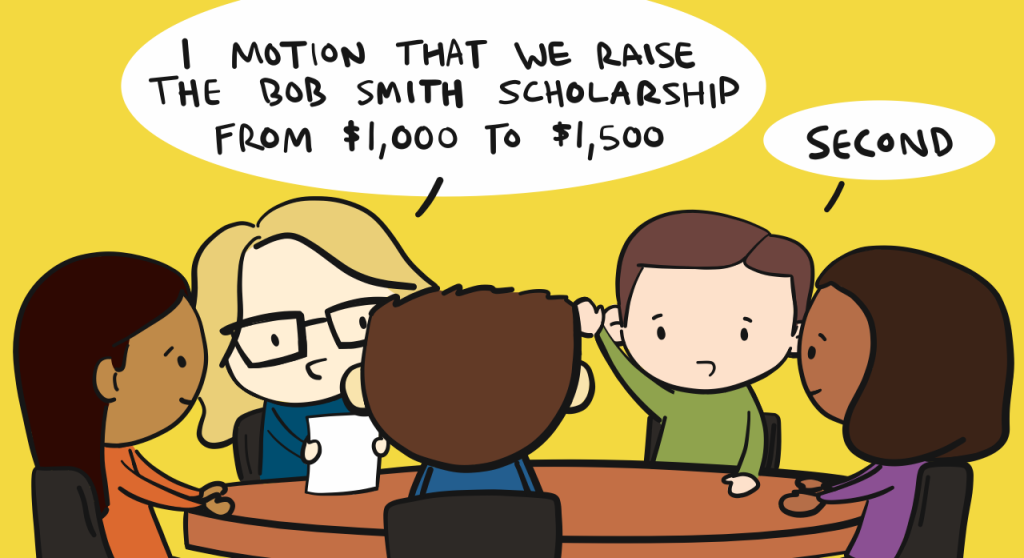Throughout your business career and personal life, you might serve on boards and committees of professional and community organizations.
It’s not a stretch to think that you might serve on multiple boards of directors at the local, state or national level. You might volunteer to help your neighborhood association or a local youth sports organization. You might join a professional trade association or be part of a church or school nonprofit.
One way to get prepared to serve with a professional organization or pitch in with a nonprofit is to learn Robert’s Rules of Order, used to run most board meetings.
Whether you serve on a local PTA, join your trade association’s state chapter or serve on a corporate board, you’ll need to understand the basics of participating in or running a board meeting, so you don’t look like a rookie.
What are Robert’s Rules of Order?
During the 1870s, Henry Martyn Robert, a U.S. military officer, compiled a set of rules that non-legislative organizations could use to run their meetings in an organized fashion. He based them on the parliamentary procedures used by the U.S. Congress.
Robert’s Rules became so popular, most organizations with a board of directors use them today, including small groups with just a few board members.
The rules help organizations officially begin a meeting, make motions, pass rules and otherwise conduct meetings with a specific agenda, order of business and system to maintain an orderly meeting.
Typical board meeting agenda
Board meetings usually use the following agenda:
- Call to order
- Introduction/recognition of guests
- President’s announcements
- Approval of previous meeting’s minutes
- Treasurer’s report
- Old business
- Committee reports
- New business
- Set the date of the next meeting
- Adjournment
Robert’s Rules of Order basics
Official meetings usually require a quorum, or a minimum number of elected or appointed board members in attendance. This number is almost always a majority of the board members. In some cases, it might be a percentage, such as two-thirds of the board.
-
Making motions
When a board member wants the board to enact a new policy, make changes to a treasurer’s report, amend submitted minutes of the previous meeting or make another official request, they make a motion.
For example, if a board member wants to change the amount of a scholarship the organization awards each year, they might say, “I motion that we raise the Bob Smith scholarship from $1,000 to $1,500.”
If another board member agrees, they second the motion by saying, “I second the motion,” or “Second.”
Once a motion has been made and seconded, the president then opens the matter for discussion. After discussion, the president closes the discussion and calls the question, or calls for a vote.
Board members can vote in favor or against the motion, they can abstain from voting, they can recuse themselves or vote “present.”
Board members often abstain from voting or vote present when they don’t have enough information on the matter, or they support most of a motion but not all of it. They recuse themselves when they have a conflict of interest.
Motions can be amended or withdrawn after discussion. For example, after board members discuss increasing the amount of a scholarship from $1,000 to $1,500, they might decide they would rather offer a $1,250 scholarship, or offer two $1,000 scholarships. The person who made the motion would then change her motion, which would then need to be seconded and passed.
Motions can also be tabled, or put on hold to revisit after the board has more information.
When you make a motion, it’s a good idea to prepare the wording in advance. Your motion might create an official act of your organization, and the secretary must record your motion word-for-word as you make it.
-
Call to order
Meetings start when the presiding board member, usually the chairman of the board or organization president, officially calls the meeting to order.
-
Approval of minutes
The next step of a board meeting is often to approve the minutes of the previous meeting. Minutes are notes taken by the secretary. A board secretary is not an administrative person, it is an elected or appointed position and a voting member of the board. If someone joins a small board, their first position might be secretary.
A secretary records the date and location of the meeting, the time it starts, who is present, who lead the meeting, who made motions, who seconded motions, discussion highlights about a motion, and the way each board member voted on each motion. The minutes also include a synopsis of the treasurer’s and committee reports.
Board members usually receive minutes in advance of the upcoming meeting so they can review and comment on them. At a board meeting, the secretary submits the minutes for approval. If anyone has questions, the secretary responds. A board member can then make a motion to accept the minutes as submitted, or to amend the minutes. If the motion is seconded, the president (or whoever is running the meeting) calls the question, closes the discussion and calls the vote. Only the meeting leader can close debate and call for a vote.
-
Adjourning a meeting
To adjourn the meeting, the president or other officer makes a motion to adjourn, the motion requires a second, and then the board votes. This is usually a very casual process with only a quick voice vote taken.
-
Legality
If an organization is a corporation, it is required to have bylaws. If an organization’s bylaws stipulate that board meetings must be run according to Robert’s Rules of Order, then all official actions taken must be done following Robert’s Rules. For example, if a board member makes a motion and no one seconds the motion, that board member can’t demand that the president call a vote simply because the board member wants everyone on the record.



